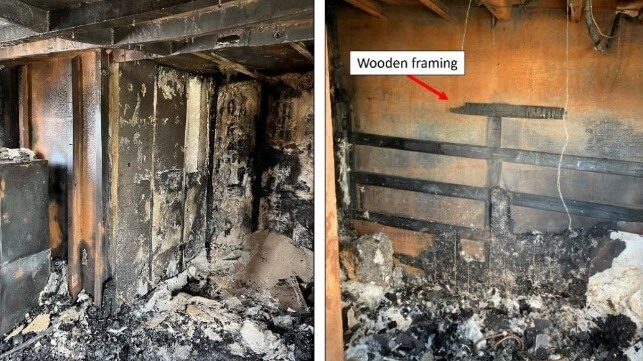NSTB: Cracked Exhaust, Flammable Interior Led to Towboat's Loss

The NTSB has released its report on the fire that destroyed the towboat Mary Dupre while it was under way on the Intracoastal Waterway last year, and has concluded that it was caused by placing an exhaust muffler on the other side of a steel plate from combustible wood paneling.
On the morning of June 26, 2022, Mary Dupre was under way on the Gulf Intracoastal Waterway, pushing a single barge of biodiesel. At about 0930 hours, the off-watch pilot was awakened by a smoke alarm and the smell of smoke in his cabin, which was located right between the towboat's two exhaust stacks. A deckhand woke up at about the same time and reported a "burning smell." They went to the wheelhouse and told the captain, who asked them to return to the cabin and find the source of the smoke. It was coming from the overhead next to the starboard exhaust stack, and they concluded it was from an exhaust leak.
At 1000 hours, half an hour after the alarm went off, the crew tore a wooden panel off the overhead to look further for the seat of the fire. The smoke quickly intensified, and they saw that the wooden framing behind the panel was charred and smoldering. Flames were visible inside the opening.
A deckhand used a dry chemical fire extinguisher to try to put out the flames, but was not successful. They could not readily access the seat of the fire behind the wooden bulkhead, and rather than overhaul with an axe and fire hose, they recorded a video and went to the exterior of the vessel to examine the exhaust stack. Smoke was coming out of the vent on the side of the stack, and the paint on the exterior was blistering.
At this point, after 1000 hours, the captain shut down the starboard engine and made a distress call.
At about 1020, the good samaritan towboat Ave Maria arrived on scene and took control of Mary Dupre's barge tow. The fire was quickly expanding out of control, and the wheelhouse filled with smoke. The captain ordered the crew to abandon ship into the towboat's skiff, and they departed safely at 1055. By 1130, the fire had engulfed the Mary Dupre's second deck level and pilothouse.
A team of salvage responders arrived at 1525, by which point the fire had burned down. They extinguished the last hot spots, and Mary Dupre was towed to a nearby shipyard for evaluation. Her insurer concluded that she was a constructive total loss.
At the yard, the local fire marshal boarded the burned vessel alongside inspectors from the NTSB and the Coast Guard. They found that the vessel had been constructed with a single steel plate between the exhaust pipe and the interior bulkhead of the pilot's cabin. On the cabin side of this plate, the bulkhead was covered with wooden framing and paneling, which showed signs of charring consistent with overheating. On the stack side of the plate, the insulation blanket on the exhaust muffler was loose and disconnected and a weld on the top of the muffler had cracked. The heat from the muffler and the leaking exhaust gases was about 10 inches away from the bulkhead, and one plate of steel away from wooden framing.
The fire marshal concluded that the most probable cause of the blaze was lack of insulation around the exhaust pipe, causing heat buildup in the stack and ignition of the wood on the other side of the bulkhead.
All maintenance records and logs for the Mary Dupre were destroyed in the fire, so the NTSB could not assess the circumstances of the vessel's maintenance before the fire.

that matters most
Get the latest maritime news delivered to your inbox daily.
In its conclusions, NTSB found that the cracked exhaust pipe and resulting heat were responsible for the fire. However, it noted that it has recorded many fires that were exacerbated by vessel interior construction with combustible materials. Structural fire protection using fire-resistant materials would help reduce risk and slow down a fire, but this is not currently required by Subchapter M; towboat and tug operators are free to use wooden materials in any manner desired to create a classic, attractive interior. Wood and other combustible materials are tightly regulated on SOLAS vessels.
"The significant combustible load in the Mary Dupre’s interior areas, including wooden framing, joinery, paneling, and other outfitting materials, indicates that the vessel was not designed with structural fire protection," concluded NTSB. "These materials served as both the ignition source and a fuel source for the fire. Once the wooden framing in the pilot’s stateroom ignited, the fire spread to the attached wooden paneling on the bulkheads and overheads, then spread quickly throughout the vessel."
